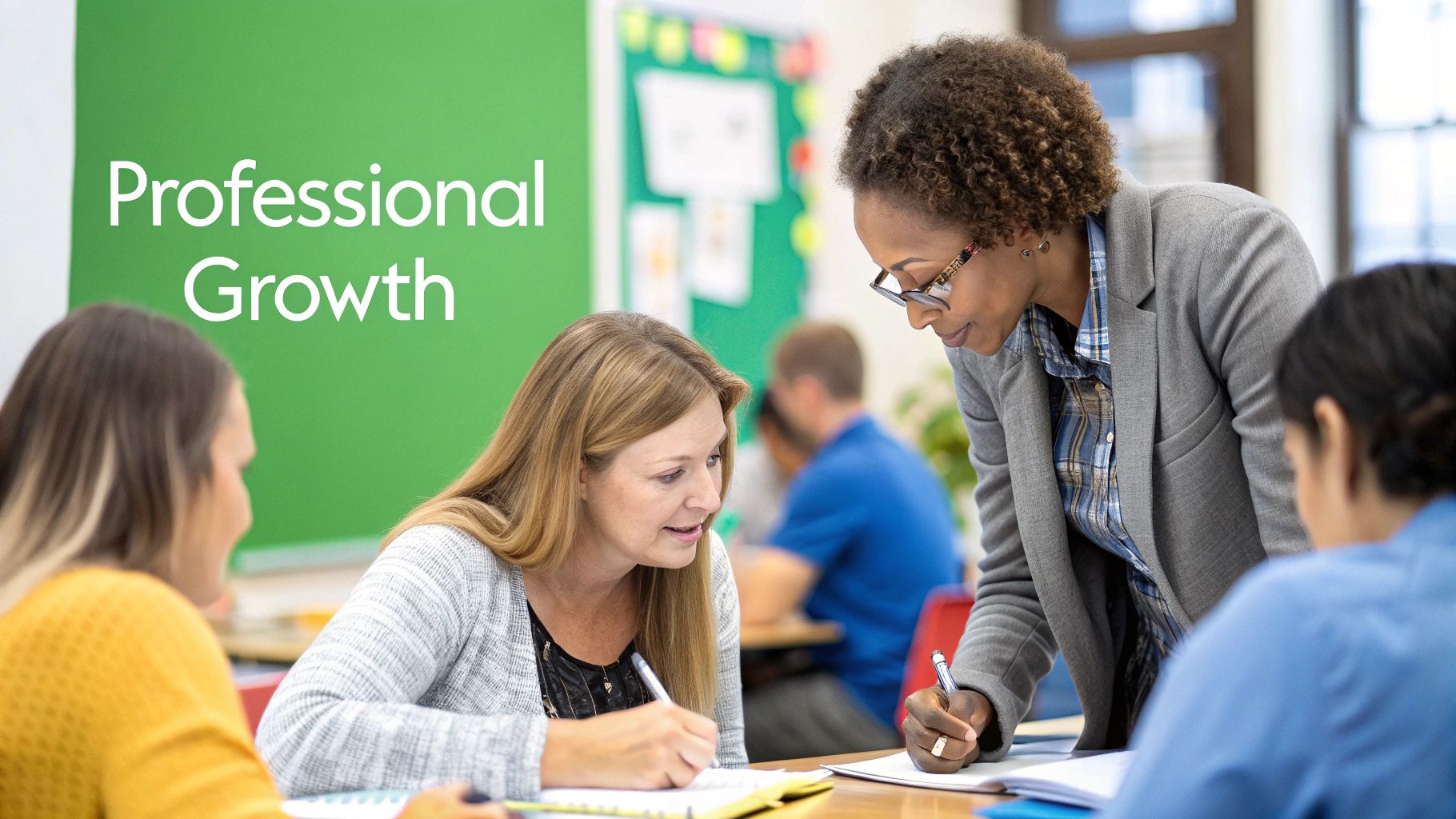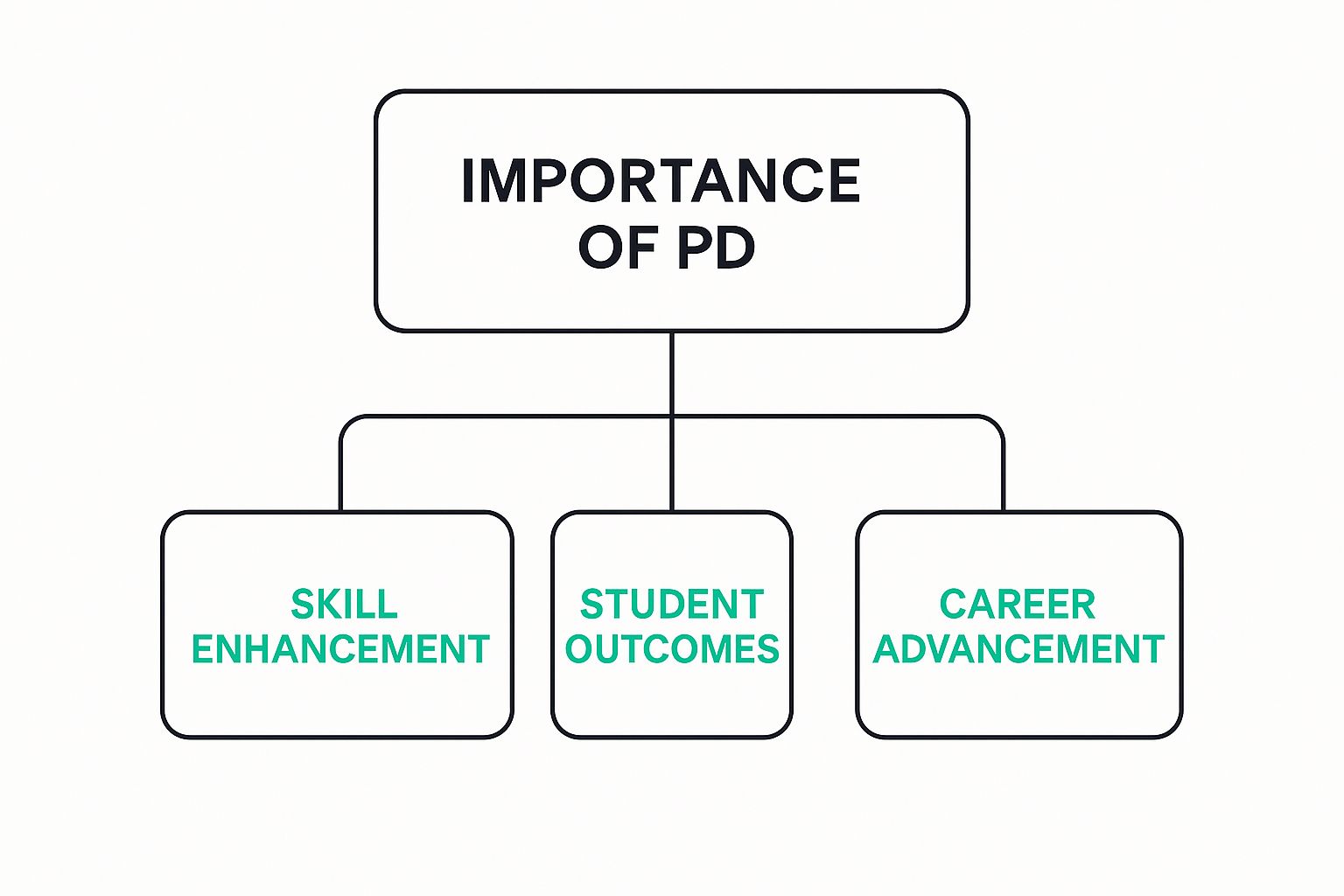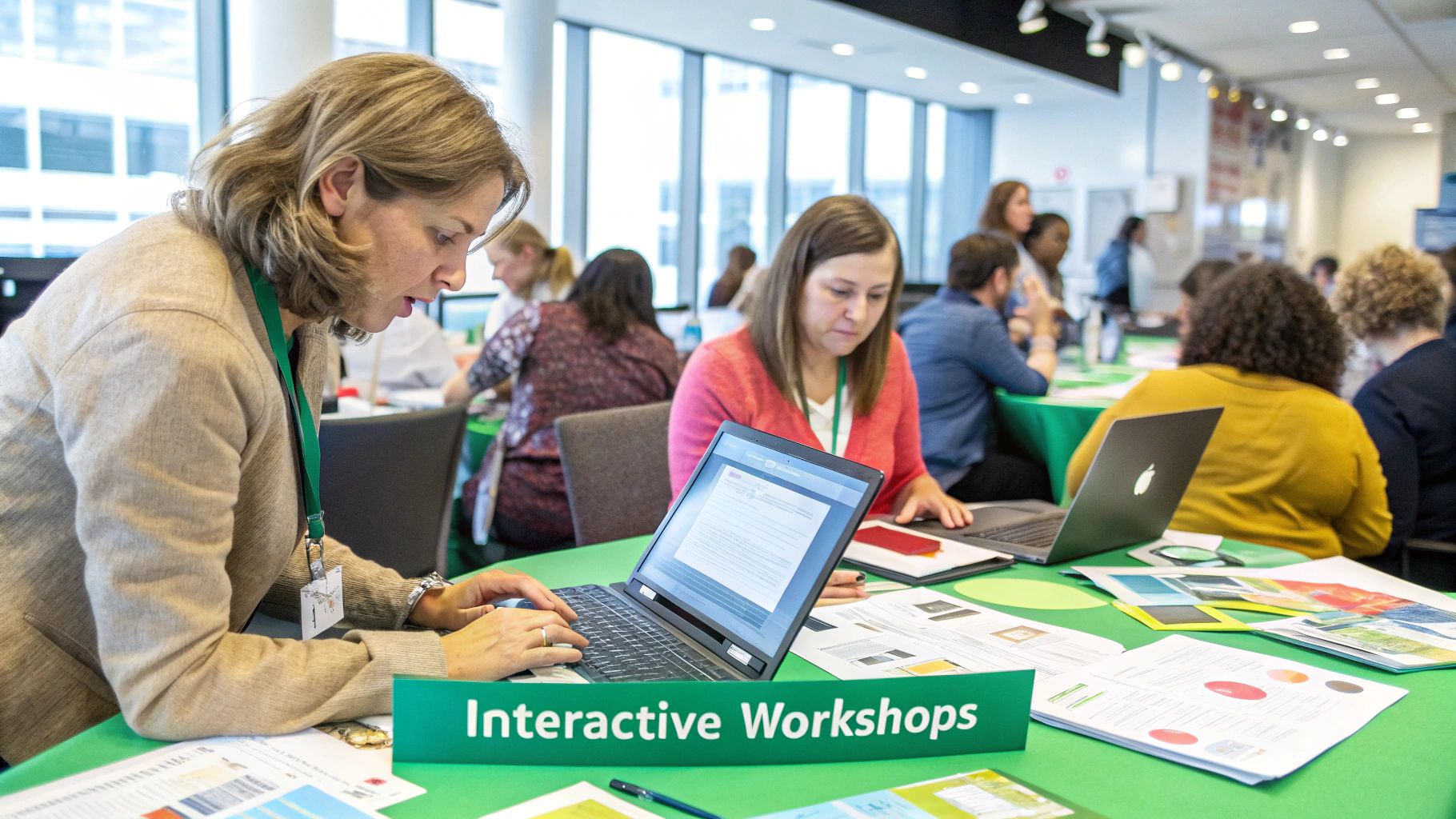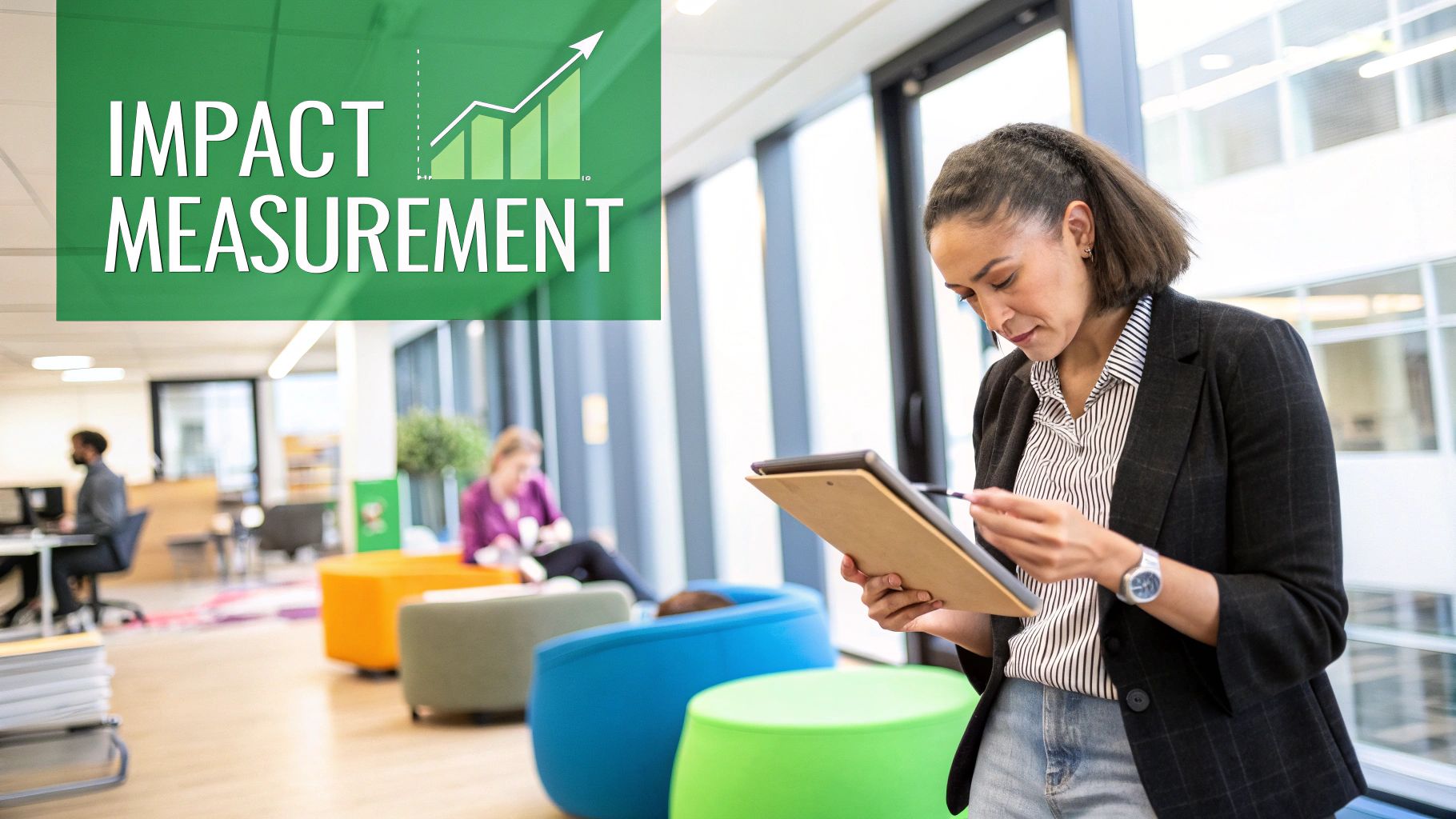Effective Teacher Professional Development Programs
Explore top teacher professional development programs that enhance teaching skills and boost student success. Discover strategies for real growth.

Let's be honest. When you hear "professional development," what comes to mind? For too long, it’s meant one-off, mandatory training days that felt more like a chore than a genuine chance to grow. But that old model is broken.
In today's complex classrooms, meaningful and continuous teacher professional development programs aren't just a nice-to-have. They’ve become the very core of what drives school improvement and, just as importantly, keeps great teachers in the profession.
Why Teacher Professional Development Matters Now More Than Ever

Think of an educator as a master craftsperson. A woodworker continually sharpens their tools and learns new joinery techniques, and in the same way, a teacher must constantly refine their skills to meet the diverse needs of modern students.
This is where high-quality professional development makes all the difference. It’s not about disconnected workshops; it's a strategic journey of constant improvement.
The Clear Link Between Teacher Growth and Student Success
The connection is direct and undeniable: when you invest in teachers, you get better student outcomes. It’s that simple.
When educators feel supported and equipped with the latest, evidence-based instructional strategies, their confidence and effectiveness in the classroom soar. This isn't just a theory; it's a proven formula for real educational progress.
Research consistently shows that those traditional, one-size-fits-all training sessions have a tiny impact on actual teaching practices. Truly effective programs are built on a few key pillars:
- Active Adult Learning: Moving beyond passive lectures to hands-on activities, peer observation, and meaningful self-reflection.
- Peer Collaboration: Creating communities where teachers can share lesson plans, solve problems, and learn from each other's successes and failures.
- Sustained Duration: Providing ongoing support and coaching over an entire semester or year, not just in isolated, short-term workshops.
A teacher's growth is a student's gain. Investing in professional development is not an expense; it is a direct investment in the quality of learning that happens in every classroom, every day.
It's More Than Just a Skill Upgrade
Beyond pedagogical techniques, these programs address the whole educator. They are a powerful tool for boosting morale, preventing the all-too-common burnout, and improving teacher retention rates.
When schools show they are willing to invest in their staff's professional journey, teachers feel valued, respected, and more committed to their roles. This creates a positive and stable school culture where both students and staff can truly thrive.
Ultimately, a strong professional development strategy is the single most critical investment a school can make. It builds a foundation of expertise, fosters a collaborative spirit, and ensures that every student is met by a prepared, passionate, and highly skilled educator.
Exploring Core Models of Professional Development
So, what does a genuinely effective teacher professional development program actually look like? Spoiler alert: it’s not a one-size-fits-all formula. The landscape of teacher growth has moved far beyond those outdated, one-off workshops we all remember. Today’s best approaches are continuous, collaborative, and tailored to what’s happening in the classroom right now.
Think of these core models as a map of the professional development world. Understanding them helps school leaders and teachers pick the right path—one that aligns with their specific goals, challenges, and school culture. Let's dig into some of the most impactful frameworks shaping teacher growth.
The Power of Collaborative Learning
At the heart of many successful programs is a simple idea: teachers learn best from each other. Collaborative models flip the script from top-down instruction to peer-driven growth. This shift creates a powerful culture of shared ownership and constant improvement.
One of the best examples is the Professional Learning Community (PLC). Imagine a PLC as a dedicated 'think tank' for a small group of teachers, usually from the same grade or subject. They meet regularly to pore over student data, swap instructional strategies that actually work, and solve classroom challenges together.
Another powerful approach is mentorship and instructional coaching. This model pairs a seasoned educator with a newer teacher or a peer who wants to sharpen a specific skill. The coach is there to provide non-evaluative feedback, co-plan lessons, and offer confidential support, creating a safe space for real professional growth.

This really drives home the point: investing in a teacher's skills is the first step toward better student learning and a more satisfying career for the educator.
Inquiry-Based and Action-Oriented Models
Some of the most effective PD programs empower teachers to become active drivers of their own learning. Instead of just passively receiving information, they’re encouraged to ask tough questions, test new ideas, and reflect on the results in their own classrooms.
A perfect example of this is Action Research. This model essentially turns teachers into "classroom scientists." An educator identifies a specific problem—like "How can I boost reading comprehension for my English language learners?"—and then systematically tests a new strategy, collects data on its impact, and adjusts their approach based on the evidence.
Action research puts teachers in the driver's seat of their professional growth. It honors their expertise and gives them the tools to make data-informed decisions that directly benefit their students.
This hands-on, cyclical process makes professional learning incredibly relevant and immediately useful. It’s not about abstract theories; it’s about finding practical solutions to real-world classroom challenges.
Leveraging Technology for Flexible Growth
Modern tech has opened up a whole new world for professional development, offering a level of flexibility and access that was once unimaginable. Online and hybrid models are perfect for the demanding schedules of educators, providing a gateway to a global network of experts and resources.
- Hybrid Online Courses: These programs blend the convenience of self-paced online modules with the collaborative energy of live virtual sessions or in-person workshops. Teachers can learn foundational concepts on their own time and use group sessions for deeper discussions and problem-solving.
- Micro-credentials: Instead of committing to a full degree, teachers can earn digital badges or certificates for mastering specific skills. This could be anything from integrating tools like EarthChasers into geography lessons to implementing project-based learning. It’s all about personalized, just-in-time learning.
These technology-powered models make continuous professional growth a realistic goal for every teacher, no matter their location or schedule.
To help visualize how these different approaches stack up, here’s a quick comparison.
Comparing Professional Development Models
Each model offers unique strengths. Choosing the right one depends entirely on your school's specific needs, from supporting new teachers to tackling district-wide curriculum goals.
| Model | Core Concept | Best For | Key Benefit |
|---|---|---|---|
| Professional Learning Community (PLC) | Small, collaborative teacher groups analyze data and share strategies. | Grade-level or subject-area teams focused on student outcomes. | Fosters a culture of shared responsibility and continuous improvement. |
| Instructional Coaching/Mentoring | One-on-one, non-evaluative support from an experienced peer. | New teachers or educators wanting to refine specific skills. | Provides personalized, confidential, and safe professional growth. |
| Action Research | Teachers systematically study and solve a problem in their own classroom. | Empowering teachers to address specific, immediate classroom challenges. | Makes PD highly relevant and directly tied to student needs. |
| Hybrid/Online Courses | A mix of self-paced digital modules and live collaborative sessions. | Teachers with busy schedules needing flexibility and access to experts. | Combines convenience with the power of collaborative learning. |
Ultimately, the most effective professional development often blends elements from several models to create a comprehensive and supportive ecosystem for teacher growth.
Principles of Effective Program Design
No matter which model you choose, research consistently shows that the most impactful programs share a few core principles. They aren't isolated events. They are sustained over time, embedded in a teacher's daily work, and focused on specific subject matter and teaching strategies.
Global research confirms that successful programs are built on active learning, ongoing mentorship, and strong peer collaboration. A key report synthesizing findings from projects in 41 countries revealed that relevance to teachers' immediate needs and sustained engagement are crucial for making a real impact. This moves us far beyond traditional, top-down training. You can explore the full research synthesis on teacher professional development to learn more about these global findings.
By understanding these core models and foundational principles, schools can move beyond compliance-driven training and build a vibrant culture of learning that truly empowers teachers and elevates student achievement.
Navigating Global Teacher Development Challenges

Effective teacher professional development programs don't exist in a vacuum. They operate inside a messy ecosystem of real-world budget cuts, systemic roadblocks, and immense pressures that can either supercharge their impact or stop them dead in their tracks.
To really get why these programs are so critical, you first have to understand the hurdles the global education community is up against. And one of the biggest is the staggering, and growing, global teacher shortage.
This isn't just a small problem in a few places—it's a full-blown worldwide crisis. The numbers are almost hard to believe.
A global report from UNESCO and the Teacher Task Force revealed that the world needs an additional 44 million primary and secondary teachers by 2030. On top of that, attrition rates have nearly doubled, with way too many educators leaving the profession in their first five years. This constant revolving door makes it nearly impossible for meaningful professional development to take hold. You can dive into the full data by reading the UNESCO report on the teacher shortage crisis.
The Link Between Attrition and Development
High teacher turnover creates a vicious cycle. When schools are stuck in a constant scramble to fill empty desks and onboard new staff, long-term, strategic planning for teacher growth gets pushed to the back burner. It's a reactive state that undermines the sustained, collaborative development models we know work best.
Instead, schools are often forced into short-term, "band-aid" training sessions that don't address the real needs of their teachers. This lack of genuine growth opportunity is a huge driver of burnout and a key reason so many talented educators walk away. They feel stagnant, unsupported, and ill-equipped to handle the classroom's evolving demands.
Investing in robust, continuous professional development isn't just about improving skills—it's a powerful retention strategy. It tells teachers, "We value you, and we're invested in your long-term growth."
This problem is universal. It hits well-funded suburban districts struggling to keep specialized staff and under-resourced schools in Sub-Saharan Africa facing chronic shortages. The core issue is the same everywhere: you can't build impactful professional learning without a stable, experienced teaching force.
Overcoming Systemic Barriers
Beyond the shortage, a few other systemic barriers routinely get in the way of high-quality professional development. Recognizing them is the first step to designing programs that actually work.
- Limited Funding: Let's be honest—when budgets get tight, professional development is often the first thing on the chopping block. This forces administrators to go for cheap, low-impact options over more effective, long-term programs.
- Lack of Time: Teachers are drowning in work. Between lesson planning, grading, and administrative tasks, finding the time for their own learning can feel completely out of reach.
- One-Size-Fits-All Approaches: A classic mistake is rolling out one generic program for an entire district. This ignores the unique needs of different teachers, subjects, and grade levels, leading to poor engagement and wasted resources.
- Disconnect from Classroom Reality: Too often, training is designed by people far removed from the day-to-day chaos of the classroom. If the content feels abstract or irrelevant to a teacher's actual challenges, it's not going to stick.
Successfully launching professional development programs means tackling these challenges head-on. It requires a fundamental shift from seeing development as an "expense" to treating it as an essential investment in a school's most valuable asset: its teachers. By building supportive systems that truly prioritize teacher growth, we can improve instruction and create a more resilient, motivated workforce ready for anything.
Tailoring Programs for Specialized School Environments
Embedded content
When it comes to professional development for teachers, a one-size-fits-all approach is a recipe for failure. You wouldn't use the same fertilizer for an orchid and a cactus, right? In the same way, a generic training program just won't work for every school. The context—a school's mission, its students, and its staff—is everything.
This is especially true in specialized environments like international schools. These schools operate under unique pressures that demand flexible, relevant, and continuous professional growth. It’s not just a nice-to-have perk; it's a critical tool for survival and success.
Meeting the Demands of a Global Classroom
International schools often serve a diverse and transient student body. This means teachers need very specific skills to manage multicultural classrooms, support English language learners, and adapt curricula for a global audience. The need for these advanced skills is always there and always changing.
One semester, a teacher might need training on the latest bilingual teaching methods. The next, they might need a deep dive into culturally responsive assessment. This requires teacher professional development programs that are agile and responsive—not rigid, pre-packaged solutions.
The best professional development programs act like a compass, not a map. They provide direction and tools but empower teachers to navigate the unique terrain of their own classrooms and school communities.
This need for specialized training is magnified by the staffing challenges these schools face. The international school sector employs roughly 713,539 staff around the world, but it also struggles with major teacher shortages. A big part of the problem is that most teachers only stay for one to six years before leaving for better growth opportunities.
Because of this, many top schools now use professional development as a core retention strategy. They offer training to support new teaching models, like bilingual education or the ethical use of AI, to keep their best talent. You can find more insights on this in ISC Research's report on teacher retention in international schools.
Using Professional Development as a Recruitment Tool
In a competitive global market, savvy schools have turned professional development into a powerful recruitment magnet. They get it: the best educators are lifelong learners who actively seek out environments that invest in their growth.
By offering high-quality, customized training, schools send a clear signal: we value our teachers and are committed to their long-term success.
This can easily be the deciding factor for a top-tier candidate weighing two different job offers. A school that highlights its strong mentorship program, funds teacher-led research projects, or provides training on innovative tools like EarthChasers to supercharge geography lessons will always have an edge.
Key Skills for Specialized Environments
While every school is different, certain skills are consistently in high demand. Effective professional development programs often focus on building teacher capacity in these critical areas:
- Bilingual and Multilingual Pedagogy: This goes beyond basic language instruction. It's about giving teachers strategies to teach core subjects effectively in multilingual classrooms.
- Ethical Technology Integration: Training teachers to responsibly use new tools, including artificial intelligence, for personalized learning without compromising student privacy.
- Global Citizenship and Cultural Competency: Providing frameworks to foster cross-cultural understanding and prepare students for an interconnected world.
- Project-Based and Inquiry-Led Learning: Helping teachers design complex, student-driven projects that build critical thinking skills relevant to a global audience.
Ultimately, tailoring professional development is about respecting a school's unique context and the expertise of its educators. It’s a strategic shift away from checkbox-driven training and toward a culture of real, continuous improvement. This approach doesn't just build better teachers—it builds stronger, more resilient, and far more attractive school communities.
How to Choose and Implement a High-Impact Program

Knowing what makes a great teacher professional development program is one thing. Actually bringing one to life in your school? That’s a completely different challenge.
Turning theory into action requires a clear roadmap—a practical playbook for selecting, launching, and sustaining a program that truly works. This is about moving past wishful thinking and building a system that delivers measurable results, fostering a deep culture of continuous learning that empowers every single educator.
Start With a Genuine Needs Assessment
The best programs always start with listening. Before you even think about different models or providers, you need to understand the real-world needs of your teachers and the specific learning gaps of your students. A top-down mandate without this foundational work is destined to fail.
First, gather the hard data. Dig into student performance metrics to pinpoint where the struggles are—is it math fluency? Reading comprehension? This gives you a clear picture of what your students need most.
But data alone doesn't tell the whole story. You have to talk to your teachers. Use surveys, focus groups, and one-on-one conversations to ask them what they need to feel more effective and supported. What challenges are they facing daily? What skills do they actually want to develop?
This dual approach ensures your program is grounded in both student data and teacher voice, making it relevant from day one.
Set Clear and Measurable Goals
Once you have a handle on your school’s unique needs, you can define what success will look like. Vague goals like “improve teaching” just won't cut it. You need specific, measurable, achievable, relevant, and time-bound (SMART) objectives.
Think of your goal as a destination on a map. Without a clear destination, you're just wandering. A well-defined goal gives direction to every decision you make along the way.
For example, a strong goal might sound like this: "By the end of the school year, 75% of our middle school science teachers will implement inquiry-based learning strategies in at least two units, leading to a 15% increase in student scores on performance-based assessments." Now that's a goal. It's specific, measurable, and tied directly to student outcomes.
Evaluate Providers Based on Proven Results
With clear goals in hand, you can start looking at potential teacher professional development programs and providers. It’s crucial to look past the slick marketing and focus on evidence of impact.
A quality provider should be able to answer these critical questions:
- What is your instructional model? Does it align with research-backed principles like active learning, peer collaboration, and sustained support?
- Can you show us the data? Ask for case studies or evidence from other schools showing how their program led to measurable changes in teaching practice and student achievement.
- How do you customize your approach? A one-size-fits-all program is a major red flag. The provider must be willing to adapt their model to fit your school's specific goals and context.
And don’t be afraid to ask for references. Talk to leaders from other schools who have used the program to get an honest, unfiltered assessment of their experience.
Secure Teacher Buy-In From the Start
Here’s the bottom line: even the best-designed program will flop if teachers don't believe in it. Getting genuine buy-in isn't about convincing your staff; it’s about co-creating the solution with them. When teachers feel like active partners in the decision-making process, their engagement and commitment will skyrocket.
"When you know that people have piloted it and it’s been used and written by teachers specifically to use in the classroom, it gives you more confidence. There’s an added respect factor."
– Marilynn Alford, 35-year veteran educator
Include teachers on your selection committee. Give them a real voice in evaluating providers and shaping the program's focus. This approach builds a foundation of trust and ensures the program you choose is one they are genuinely excited to be a part of.
Foster a Culture of Continuous Learning
Finally, remember that implementation is not a one-time event. It's an ongoing process that demands consistent support, encouragement, and resources. School leaders must champion the program and model a commitment to lifelong learning themselves.
Here are a few ways to build a supportive culture:
- Provide Protected Time: Carve out dedicated time during the school day for teachers to collaborate, observe peers, and practice new skills.
- Celebrate Small Wins: Publicly recognize teachers who are trying new strategies and making progress. This creates positive momentum and encourages others to jump in.
- Encourage Collaboration: Create structures like Professional Learning Communities (PLCs) where teachers can support each other and share what's working.
- Offer Ongoing Support: Make sure instructional coaches or mentors are available to provide in-classroom support as teachers put new practices into action.
By following this strategic roadmap, school leaders can move beyond compliance-driven training and build a dynamic professional learning ecosystem that leads to real, lasting change in the classroom.
Common Questions About Teacher Professional Development
When school leaders and teachers start looking into teacher professional development programs, the same questions pop up time and time again. Let's cut through the noise and tackle these head-on with some straight answers.
Getting clear on these points is the first step toward making smart decisions that actually help your students and staff thrive.
What Is the Most Effective Form of Teacher Professional Development?
This is the million-dollar question, but there's no magic bullet. The truth is, the most impactful programs aren't defined by a single model. Instead, research consistently points to a few shared traits.
Effective professional development is sustained over time, not a one-and-done workshop. It focuses on specific subject matter and encourages active collaboration among teachers. It’s a process, not an event.
Think about models like instructional coaching or Professional Learning Communities (PLCs). They work so well because they are woven into a teacher's daily routine, offering continuous, relevant support right where it's needed. The real key is matching the right model to your school's unique goals and your teachers' specific needs.
How Can We Measure the ROI of a Professional Development Program?
Measuring the return on investment (ROI) for professional development means looking beyond the "smile sheets." It's great if teachers enjoyed the training, but the real test is whether it sparked tangible, positive change.
The ultimate return on investment for any teacher professional development program is a measurable, positive impact on student learning and a noticeable reduction in costly teacher turnover.
To get a clear picture of your ROI, you need to track a few key metrics:
- Changes in Classroom Practice: Are teachers actually using the new strategies? This can be tracked through direct observation or even teacher self-reports.
- Student Assessment Data: Look for clear improvements in student learning, whether through test scores, project outcomes, or other performance data.
- Teacher Retention Rates: Keep an eye on your turnover rates. A great PD program should help build a more stable, satisfied, and effective teaching staff.
How Can Technology Improve Professional Development?
Technology has been a game-changer, making professional development more flexible, personal, and accessible than ever. It shatters geographical barriers and allows learning to fit into the packed schedules of today's educators.
Online platforms, for example, give teachers a library of on-demand courses they can tackle at their own pace. This lets them dig into topics that are directly relevant to their classroom right now, without ever having to leave campus.
On top of that, virtual coaching can connect a teacher in a rural district with an expert mentor halfway across the world. Digital collaboration tools can also build powerful peer networks that go far beyond the walls of a single school. Technology is what makes continuous, self-directed learning a practical reality.
What Is the Teacher's Role in Their Own Professional Growth?
The best teacher professional development programs see educators as the drivers of their own learning, not just passive passengers. The old, top-down model where administrators simply dictate training topics is fading fast because it just doesn't work as well.
Real success comes from empowering teachers with a genuine voice and meaningful choice in their own development. This means bringing them into the process from the very beginning:
- Identifying Needs: Teachers are on the front lines. They have unmatched insight into their own skill gaps and what their students are struggling with.
- Choosing Opportunities: Engagement skyrockets when educators can pick training that aligns with their personal interests and professional goals.
- Collaborating with Peers: When you create systems for teachers to share what they're learning and support each other, those new skills are far more likely to stick.
When teachers become co-creators of their own growth plan, the training is more relevant, their motivation soars, and the impact on the classroom is undeniable.
Ready to bring engaging, educational adventures into your classroom? EarthChasers offers a unique way for students to explore global geography through a fun and interactive 3D game. Learn more and start your journey at https://earthchasers.com.
